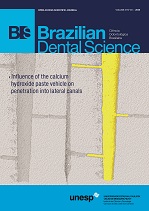Effect of different impression methods and ceramic materials on adaptation of inlays
DOI:
https://doi.org/10.14295/bds.2018.v21i3.1543Abstract
Objective: The aim of this study was to evaluate the internal and marginal adaptation of inlays fabricated from different types of impressions (conventional and digital) and different ceramics (feldspathic and lithium disilicate). Material and Methods: Forty premolars were prepared for all-ceramic inlay restoration and assigned to 4 groups (n=10), according to the impression method (conventional with addition silicone and digital impressions) and ceramic type (lithium disilicate and feldspathic ceramic blocks). For each type of impression, 10 inlays were fabricated from lithium disilicate blocks and the other 10 from feldspathic ceramic blocks, by means of the CAD-CAM system. The internal adaptation was analyzed by replica. The marginal fit was analyzed under a stereomicroscope by directly measuring the gap formed between the inlay and the tooth in the proximal and occlusal regions. Results: The marginal or internal adaptations were not affected by type of impression (conventional = digital impression), irrespective of the ceramic type. Only the internal adaptation was affected by material, i.e., feldspathic ceramic had lower values than disilicate ceramic, when considering the digital impression. Conclusion: The conventional and digital impressions promote similar marginal and internal adaptation of tested feldspathic and disilicate ceramic inlays. For digital impression the feldspathic ceramic showed better internal adaptation than lithium disilicate.
Keywords
Ceramics; Dental internal adaptation; Dental marginal adaptation; Dental impression technique.
Downloads
Downloads
Published
How to Cite
Issue
Section
License
Brazilian Dental Science uses the Creative Commons (CC-BY 4.0) license, thus preserving the integrity of articles in an open access environment. The journal allows the author to retain publishing rights without restrictions.
=================




























